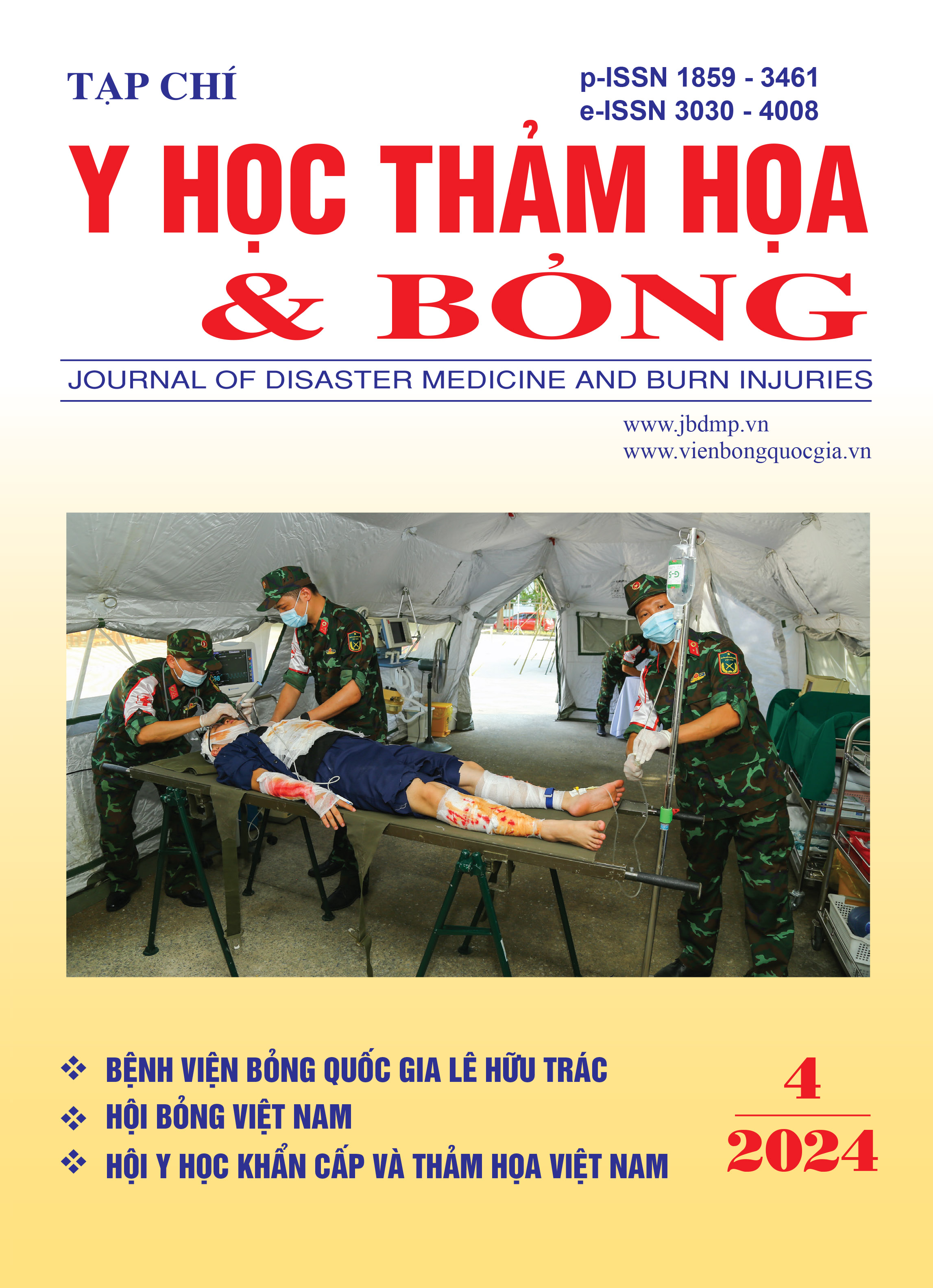Research on the relationship between ABO blood group characteristics and treatment outcomes in adult burn patients
Main Article Content
Abstract
Aims: To study the relationship between ABO blood group characteristics and treatment outcomes for adult burn patients.
Subject and methods: A retrospective study on 664 adult burn patients with TBSA of 20% or more admitted to the National Burn Hospital from January 2021 to June 2023.
Results: The average age of study patients was 42.2 years old. The main cause of burns was dry heat, accounting for 67.2%. The average total burn surface area (TBSA) was 42.5% and the average deep burn area was 15.9%. The average hospital stay was 34.07 days. There was a statistically significant difference in the mortality rate and the rate of adult burn patients with combined diseases compared to blood groups (p < 0.05). Blood group B was a factor that increased the risk of death in burn patients (OR = 1,598; p = 0.04; 95%CI 1,022 - 2,500).
Conclusion: Adult burn patients with blood type B had a higher risk of death from severe burns compared to other blood types.
Article Details
Keywords
ABO blood group, severe burns, ICU
References
2. Ewald, D.R. and S.C. Sumner, Blood type biochemistry and human disease. Wiley Interdiscip Rev Syst Biol Med, 2016. 8(6): p. 517-535.
3. Than, N.G., et al., PP13, maternal ABO blood groups and the risk assessment of pregnancy complications. PLoS One, 2011. 6(7): p. e21564.
4. Yao, R., et al., The Impact of Blood Type O on Major Outcomes in Patients With Severe Burns. J Burn Care Res, 2020. 41(5): p. 1111-1117.
5. Kowal-Vern, A., et al., Infections and ABO Blood Groups in Burn Patients. Blood, 2005. 106(11): p. 4179-4179.
6. Nguyễn Như Lâm và cộng sự (2014). Đặc điểm bỏng hàng loạt điều trị tại Viện Bỏng Quốc gia trong giai đoạn 2008 - 2013. Tạp chí Y học Thảm họa và Bỏng, 5 (2014): tr.g.9-17.
7. Elkafssaoui, S., et al., Epidemiological analysis of burn patients in the military hospital, Rabat, Morocco. Annals of burns and fire disasters, 2011. 24(3): p. 115.
8. Đặng Hoàng Nga (2002). Nghiên cứu tình hình thu dung và điều trị bỏng ở tuyến bệnh viện tỉnh thuộc 4 tỉnh miền núi vùng Đông Bắc trong 4 năm 1998 - 2001. Luận văn Thạc sĩ, 2002.
9. Ortiz-Prado, E., L. Armijos, and A.L. Iturralde, A population-based study of the epidemiology of acute adult burns in Ecuador from 2005 to 2014. Burns, 2015. 41(3): p. 582-589.
10. Phạm Quang Vinh, N.H.T., Bài giảng sau đại học Huyết học - Truyền máu, ed. 1st. Vol. 1. 2019, Hà Nội: Nhà xuất bản Y học.
11. Lowe, J.B., The blood group-specific human glycosyltransferases. Baillieres Clin Haematol, 1993. 6(2): p. 465-92.
12. He, M., et al., ABO blood group and risk of coronary heart disease in two prospective cohort studies. Arterioscler Thromb Vasc Biol, 2012. 32(9): p. 2314-20.
13. Steinvall, I., et al., ABO blood group and effects on ventilatory time, length of stay and mortality in major burns a retrospective observational outcome study. Burns, 2022. 48(4): p. 785-790.
14. Yao, R., et al., The Impact of Blood Type O on Major Outcomes in Patients With Severe Burns. Journal of Burn Care & Research, 2020. 41(5): p. 1111-1117.


